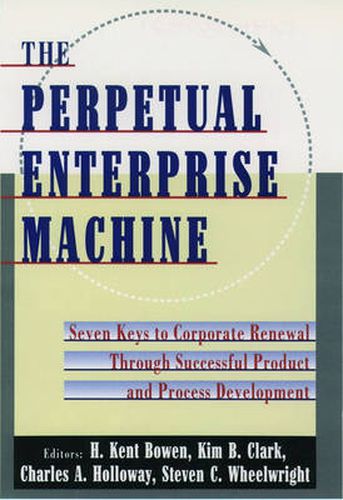Readings Newsletter
Become a Readings Member to make your shopping experience even easier.
Sign in or sign up for free!
You’re not far away from qualifying for FREE standard shipping within Australia
You’ve qualified for FREE standard shipping within Australia
The cart is loading…






U.S. manufacturing is today in a critical period. As a consequence of new global competitors, changes in technologies, and significant shifts in national priorities, our manufacturing base has shrunk alarmingly and thousands of manufacturing jobs have been lost. To address this problem, a unique team was formed called the Manufacturing Vision Group, which included members from five major companies (Chaparral Steel, DEC, Ford Motor Company, Hewlett-Packard, and Eastman Kodak) and four major universities (Harvard, MIT, Purdue, and Stanford). In The Perpetual Enterprise Machine, this group argues that the manufacturer that can initiate successful projects–leading to new products and processes–will be the one that prospers in the years ahead. They reveal how to launch a successful project and how projects can be mechanisms for growth and learning for the firm.The Perpetual Enterprise Machine outlines seven critical elements that outstanding development projects have in common, principles that can be powerful engines of success for the manufacturer facing the challenges of today’s fiercely competitive environment. Successful firms are able to use their Core Capabilities across functions, to bring together disciplines and personnel crucial to the success of the program. They have a Guiding Vision, shared by all members of the project team, that helps coordinate the actions of workers with different skills and priorities. They Push the Performance Envelope, striving to make the improvements needed to cope with a rapidly changing competitive environment. They have Leadership, someone who can navigate uncertain terrain, who sees the project’s essential elements and how they fit together. They instill the team with a sense of Ownership and Commitment, linking their personal success, status, and esteem to accomplishing project goals. They use Prototyping to learn rapidly and reduce mistakes. And they Integrate within Projects, approaching individual tasks in terms of a system-wide solution. Throughout the book, the authors illustrate these seven principles with real life case histories. We see the story behind Kodak’s development of the FunSaver camera (done on a unique CAD/CAM system that greatly helped integration and shortened the lead time from design to production); Ford’s 1991 Crown Victoria, the first project launched under their Concept-to-Customer system; Chaparral Steel’s development of the world’s first horizontal steel caster; and Hewlett-Packard’s wildly successful DeskJet printer.The Perpetual Enterprise Machine delivers the insights of some of the top minds from industry and academia on one of the primary concerns of American business–how to revitalize our manufacturing industries. Visionary–yet engaging and immediately accessible–it gives managers the opportunity to profit from the trials and triumphs of five major corporations, and helps them shape the kinds of projects that will thrive and prosper in the years ahead.
$9.00 standard shipping within Australia
FREE standard shipping within Australia for orders over $100.00
Express & International shipping calculated at checkout
U.S. manufacturing is today in a critical period. As a consequence of new global competitors, changes in technologies, and significant shifts in national priorities, our manufacturing base has shrunk alarmingly and thousands of manufacturing jobs have been lost. To address this problem, a unique team was formed called the Manufacturing Vision Group, which included members from five major companies (Chaparral Steel, DEC, Ford Motor Company, Hewlett-Packard, and Eastman Kodak) and four major universities (Harvard, MIT, Purdue, and Stanford). In The Perpetual Enterprise Machine, this group argues that the manufacturer that can initiate successful projects–leading to new products and processes–will be the one that prospers in the years ahead. They reveal how to launch a successful project and how projects can be mechanisms for growth and learning for the firm.The Perpetual Enterprise Machine outlines seven critical elements that outstanding development projects have in common, principles that can be powerful engines of success for the manufacturer facing the challenges of today’s fiercely competitive environment. Successful firms are able to use their Core Capabilities across functions, to bring together disciplines and personnel crucial to the success of the program. They have a Guiding Vision, shared by all members of the project team, that helps coordinate the actions of workers with different skills and priorities. They Push the Performance Envelope, striving to make the improvements needed to cope with a rapidly changing competitive environment. They have Leadership, someone who can navigate uncertain terrain, who sees the project’s essential elements and how they fit together. They instill the team with a sense of Ownership and Commitment, linking their personal success, status, and esteem to accomplishing project goals. They use Prototyping to learn rapidly and reduce mistakes. And they Integrate within Projects, approaching individual tasks in terms of a system-wide solution. Throughout the book, the authors illustrate these seven principles with real life case histories. We see the story behind Kodak’s development of the FunSaver camera (done on a unique CAD/CAM system that greatly helped integration and shortened the lead time from design to production); Ford’s 1991 Crown Victoria, the first project launched under their Concept-to-Customer system; Chaparral Steel’s development of the world’s first horizontal steel caster; and Hewlett-Packard’s wildly successful DeskJet printer.The Perpetual Enterprise Machine delivers the insights of some of the top minds from industry and academia on one of the primary concerns of American business–how to revitalize our manufacturing industries. Visionary–yet engaging and immediately accessible–it gives managers the opportunity to profit from the trials and triumphs of five major corporations, and helps them shape the kinds of projects that will thrive and prosper in the years ahead.